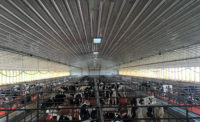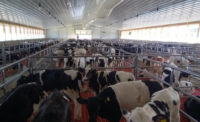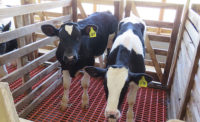Veal producers are searching for profitability as they work through the current marketing situation affecting the industry.
The traditional supply of veal calves has declined significantly as the beef cattle population in the U.S. reaches 50-year lows. An estimated 3 million to 4 million dairy calves a year that have traditionally been potential veal calves are being raised for beef. Plus, the current high finished price for veal calves is making it difficult for packers to move the meat because of record high retail prices.
“A calf that went for $3.50 a pound a year ago is now between $4 and $4.20,” said Jurian Bartelse, a past president of the American Veal Association. “That looks good on paper, but selling expensive meat is also a challenge.”
Market analysts say demand for veal peaked in May 2012, then declined by 23 percent through April 2014. Demand was expected to improve due to seasonal factors in the second half of 2014, but will likely remain below last year.
“They say that veal demand is down, but I contend it’s the veal supply that’s dwindling and cannot keep up with potential demand if we had the calves,” Bartelse said.
Feed costs rising
The increased cost of a traditional milk-fed veal diet is also problematic as certain dairy byproducts have become more popular for human consumption. Whey, for example, goes into a lot of things like granola bars, bread, protein powders, baby formula, etc. Using dairy byproducts for animal feed is not as economically viable as it once was.
The answer? Some think American veal producers might look to the European model.
“We’ve taken a lot of cues from the Europeans over the years,” said Bartelse. “We’re already adopting their housing systems. Adopting their diet system might be the way to go in order to return us to profitability.”
European producers have switched to more of a 50/50 diet — 50 percent milk-based products and 50 percent pellets made from corn, barley or other grains.
It results in a calf that’s much less expensive to produce but it’s also slightly different than what is currently produced here in the U.S. It’s not a true milk-fed calf.
Group housing progress
In 2007, the veal industry committed to switching to group housing systems by 2017. Resources estimate between 50 and 75 percent of producers have completed the transition. Producers who have adopted any kind of group housing system are taking a step in the right direction.
The ideal system, in Bartelse’s opinion, would involve housing calves in individual stalls initially in order to give them special attention in what he calls “that critical first two or three weeks” before moving them into groups.
“I think that’s what a lot of the industry is doing,” he said.
Marketing efforts
Despite the record high cost of veal production there are still many affordable cuts of veal such as Shoulder Chops, Loin Chops, Short Ribs and Skirt Steaks. In addition to these cuts, ground veal is a great value for traditional favorites such as burgers, meatballs and Bolognese.
“These items are still very affordable for use both at home and any type of restaurant,” explained Anthony Catelli, president and CEO of Catelli Brothers, Inc.
“Most of our center-of-the-plate items are still comparable in price to today’s high-end beef cuts. The bottom line is “veal is still a deal!”
The Beef Checkoff-funded veal promotion program focuses on increasing demand for veal with current users and creating a position for veal with the Millennial demographic and channel decision makers. Recent marketing events included a July summer grilling Facebook promotion encouraging consumers to experience veal on the grill and partnering with Pabst Blue Ribbon on a consumer veal recipe contest supported by the New York Beef Industry Council, the Pennsylvania Beef Council and the Northeast Beef Promotion Initiative.
The Veal Made Easy consumer Web site was refreshed this past year. The new site is easy to navigate, recipe-focused and mobile friendly. It is designed to reach the always-on-the-go Millennials and those consumers who already know and love veal. The Web site is www.VealMadeEasy.com
Additionally, the Beef Checkoff-funded Veal Quality Assurance (VQA) program has been updated and will be launched to the industry this fall. The program was developed by farmers, veterinarians, animal health specialists and other experts to provide the education and resources necessary to ensure that those who care for veal calves meet their ethical obligation to the animals’ health and well-being through responsible, science-based best practices and standards.
The goal of the VQA program is to build consumer trust and confidence in veal and to demonstrate the industry’s commitment to producing a safe, nutritious and delicious veal product for our customers. The level of consumer confidence in veal significantly affects consumers’ eating habits and impacts the future of the veal industry.
The U.S. veal industry has made extraordinary advancements, from the voluntary commitment to make a change in housing practices to focusing on decreasing violative residues. This commitment to continuous improvement is vital to the long-term success of the U.S. veal farmer.




Report Abusive Comment